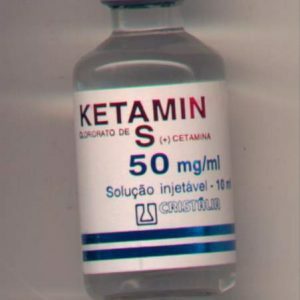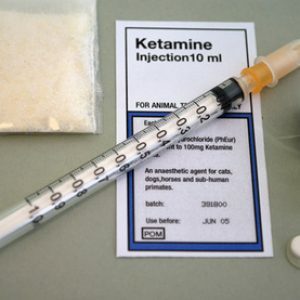Abuse of ketamine: ketamine as a drug, addiction

Ketamine is a medicinal product used in medicine since the early 60s of the 20th century.The drug served as the opening of a new era of general anesthesia for short-term and emergency surgical, gynecological interventions, as well as for facilitating the implementation of painful methods of instrumental diagnosis.Especially in cases that have a limitation for the use of barbiturates and opioid drugs.The positive effect of this medication was also in cases of bronchospasm. Due to concomitant psychedelic effects, abuse of ketamine has spread among dependent people.
The drug has analogs, which are most known under the names - calypsole, ketanest, ketalar.
Table of contents: General information How does ketamine work on humans? Doses, dependence and abuse of ketamine. Intoxication with ketamine abuse. Abstinence syndrome. Treatment of abuse of ketamine. Forecasting the abuse of ketamine.General information
When used in many patients, the drug causes excitement and an influx of hallucinatory vision.These side effects are particularly pronounced in patients with drug and alcohol dependence.
Among the addicts, ketamine gained fame through the books of M. Moore and G. Allllounian, who colorfully described the effect of the drug on the basis of their own experience.
 In practice this medicine is used in theaters of military operations of local wars, as well as in veterinary medicine.
In practice this medicine is used in theaters of military operations of local wars, as well as in veterinary medicine.
In the USSR, this medicine appeared since the 80s of the last century.And since the 90s, it has begun to spread actively as a narcotic psychedelic drug. In 1998, officially classified as a drug in Russia.
The use of ketamine was accompanied by a series of high-profile criminal scandals.
Please note: this drug was especially popular in the youth environment due to its "bright" experiences against the background of "heavy" opium and expensive cocaine.
How does a person act on ketamine
The effects of the drug are based on its selective inhibition of individual parts of the cortex and the thalamus.In doing so, it delays the speed of the functions of the limbic system and the hippocampus( causing a perversion of awareness of sensations).These processes lead to disorders of the connections between the divisions, especially the midbrain and thalamus.In medicine, this condition is called dissociative anesthesia( in which a marked change in human consciousness occurs). Ketamine has an effect on opioid receptors, causing anesthesia and related psycho-effects.By acting on the cholinergic receptors, the substance promotes the expansion of the bronchi and the development of a specific delirious state.
Doses, dependence and abuse of ketamine
Among drug addicts using this substance, the most popular intramuscular method of administration.It is considered particularly effective due to the "optimal" combination of the dose and the duration of the narcotic effect. Intravenous use causes a brighter euphoria, but which lasts much less( up to 30-60 minutes) than with intramuscular injection( several hours).
Rarer include intranasal( inhalation) and oral( ingestion) methods of anesthesia.
Initial doses are on the average 0.5-0.6 ml of a 5% solution of ketamine.Gradually emerging tolerance( stability) causes the patient to increase the dose several times.
As noted above - the main consumers of ketamine are adolescents.The initial taking of the drug takes place in the group.The main motive is to imitate those who have already experienced its action e. The group form of anesthesia is the initial period of dependence formation.It is in them often a combination of drugs and effects.
Only those who have experienced a dangerous condition for life or health leave the group.
For the remainder, staying in a micro-collective environment becomes the only stimulus expected in life.Without a familiar environment, and without a drug, a teenager begins to experience boredom, mental discomfort, emotional instability. Parents, unfortunately, notice the change in the behavior of their children too late due to the fact that the action of ketamine has time to end within a few hours.The young man or girl is already at home in a normal( conditionally) condition.
We recommend to read:  Please note: since the product requires material means, teenagers start stealing money from their parents, and in other places.
Please note: since the product requires material means, teenagers start stealing money from their parents, and in other places.
If at this point the group can catch on the facts of narcotics and theft, identify and isolate the leader, then this communication can stop, as well as taking the drug.
People who continue to take psychoactive substances are gradually developing and strengthening their mental and physical dependencies.The previous doses do not have any effect, the narcotization is moving to a systematic level.Teens begin to skip classes, study, lose interest in ordinary life.Their attention is only one desire - the reception of a drug.
Often the whole group turns to heavier drugs.In this case, the composition of young addicts is reduced to a few people with an already expressed degree of addiction.
The intoxicating effect of the abuse of ketamine
The ketamine intoxication is divided into three or four phases:
- The drug appears after 5-10 minutes after ingestion( consider the most common - intramuscular injection method).The duration of 1 phase is 2-3 minutes.The patient has: relaxation( pronounced relaxation), calm, light and pleasant dizziness, peculiar taste sensations.
- The duration of this phase is limited to 2-4 hours.In this condition, the patient feels physical and mental recovery, the mood improves.In the body there is lightness, airiness, flexibility, some derealization, which drug addicts call "weightlessness."Patients feel that their own body varies in size and volume.
- This phase develops when a large dose of ketamine is taken.The intoxication of the 2nd phase gradually disappears and is replaced by irritability, weakness.Patients look tired, sluggish answer questions, they are inhibited all reactions. There is a feeling of absence of one's own body( dimorphophobia).Develops mental derealization, suspicion, ideas of persecution and fear .These manifestations are accompanied by illusory-hallucinatory experiences, the vision of pictures, the hearing of music.On examination, the patients are pale, the pupils are markedly expanded, the coordination is broken, the heart rate is increased by 20-30 strokes, the blood pressure is steadily increased.
- The terminating phase lasts 1-2 hours, and is characterized by a sharply reduced sensitivity, which is sometimes absent.There is nausea, marked weakness, the peak of coordination disorders.Gradually, all phenomena go away.
Please note! With regular reception, the first phase is practically absent, or a few seconds are felt.The manifestations of the second and third phases merge together.
After a few months, patients are trained in drug self-regulation.They eliminate feelings of fear, direct hallucinations, making it easier, or completely eliminating negative feelings from ketamine.
In sober moments, a constant form of absent-mindedness, confusion, attention, memory functions develops.Thinking loses logic, depth.The patients are morally down.Externally, they lose weight, on the coarse skin there are pathological rashes.Increased blood pressure gives impetus to the development of headaches.Patients suffer from tachyarrhythmias( severe palpitations).
Note: Against the backdrop of ketamine deprivation, drug abusers clearly show abstinence.
Syndrome of withdrawal( abstinence)
No psychoactive substance causes in patients:
- insomnia, fears;
- dizziness, headache, trembling in the body and sweating( vegetative disorders);
- state of general malaise and discomfort;
- pulling and aching pain in the muscles, which are very depressing patients.
Dependents are in every way looking for the possibility of anesthesia, begging and seeking under any pretext funds for drugs.An abstinence syndrome lasts from a day to two weeks.
Treatment of abuse of ketamine
No special treatment is required at the initial stages of drug use. In order to explain the possible consequences, experienced teachers and psychologists cope.In some cases, individual sessions with a teenager and family psychotherapy may be required.
In more advanced cases, it is necessary to intervene with narcologists.Out-patient treatment implies drug therapy of existing mental disorders( with the use of antidepressants, tranquilizers) .Disorders from the heart( increased heart attacks and high blood pressure) are eliminated by individual selection of the required medications.
Note: under adverse social conditions in an environment, a pathological mental background requires inpatient therapy.
The clinic undergoes a thorough physical examination and, most importantly, psychological research and correction.
In the hospital there are more opportunities for using rational and group psychotherapy .Behavioral correction, esthethotherapy, healing sessions of hypnosis allow to achieve a good effect.With treatment in these cases, one should not hurry to limit the patient's return to the usual environment as much as possible.
The best solution is to continue recovery in the rehabilitation center with the subsequent change of residence, work and the surrounding society.
In severe cases, the abuse of ketamine requires massive medical therapy with detoxification, the use of neuroleptics( with psychotic disorders).At the output of acute manifestations, restorative treatment with nootropics is required.
Prognosis for the abuse of ketamine
The outcome of the dependence is determined by the age of the patient, the experience, the environment and the quality of psychocorrection, treatment.A timely therapy allows you to achieve a good remission or even a complete cure, provided for a lifetime withdrawal from the drug.
It should be remembered that in the case of a duration of the dependence period of more than 1 year, the patients develop a serious psychoorganic syndrome, which is poorly amenable to reverse development. If the experience of narcotization exceeds 3-4 years, then the patients develop severe dementia, degradation with desocialisation, moral devastation, rudeness, indifference to themselves, others, loss of the purpose of life .In addition to ketamine and other drugs of such patients, there is practically nothing to worry about.In this case, the psychoactive substance stops giving sensations.Patients take it for the sake of maintaining a sane state or switch to heavier types of narcotic drugs.In this case, the forecast is unfavorable.
"Ketamine Village" China, video BBC:
Alexander Lotin, medical reviewer



